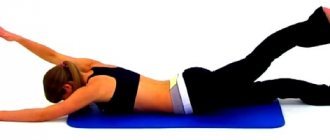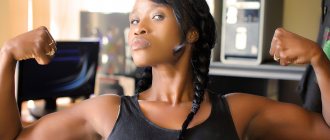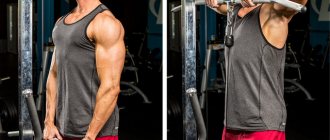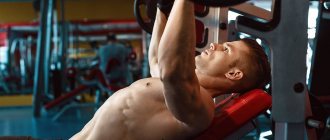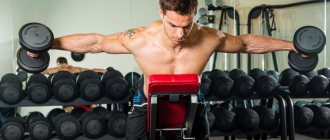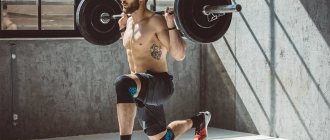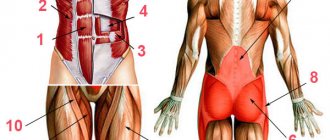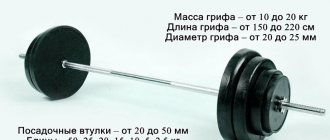Types of exercises and technique
Here we come to the most interesting part! Here I will talk about the main and effective exercises for pumping up your arms. They are divided into 2 groups: basic and insulating.
Basic
Basic exercises are our everything! They provide a heavy load, use several muscles and form the basis of the workout.
To the delta
- Barbell Chest Press
I.p.: sitting on a bench, feet resting on the floor, bar lying on the chest, grip shoulder-width apart.
Squeeze the barbell upward until your arms are fully straightened. Do not lean your body forward or backward; your arms and torso remain perpendicular to the floor.
- Barbell row to the chin
IP: standing, grip slightly narrower than shoulder width.
Bend your elbows and pull the barbell up. Your goal is to raise your shoulders parallel to the floor.
Tip: If you feel discomfort in your wrists, use a curved barbell.
For biceps
- Barbell curls (picture on the left)
IP: feet shoulder-width apart, elbows pressed to the body and slightly forward.
Raise the barbell up without lifting your elbows from your body. Hold at the top point and take an i.p.
Tip: Don't lift the bar too high, otherwise you will take the tension off your biceps.
- Reverse close grip pull-ups (picture on the right)
IP: grip slightly narrower than shoulders, palms facing yourself. Elbows pressed to the body.
Try to make the movement come from your hands; do not help yourself with your whole body, otherwise the load will be redistributed.
For triceps
- Dips
Keep your body absolutely straight. Don't lean forward. At the top point, fully straighten your arms.
Tip: If your gym has V-shaped bars, use a narrow grip.
- Close grip bench press
IP: lying on a bench, legs bent at the knees and resting on the floor. The lower back is arched. The grip is closed, shoulder-width apart or narrower. Arms are straightened, palms facing away.
As you inhale, slowly lower the barbell to your lower chest. With effort, return to the rep position, squeezing the barbell upward.
Tip: do not move your elbows away from your body, otherwise the load will transfer to the pectoral muscles.
Insulating
Isolation exercises are aimed at working one specific muscle. They form the desired relief and polish the result.
On the shoulders (delta)
- Dumbbell flyes in a standing position (picture on the left)
IP: standing, arms with dumbbells slightly bent at the elbows. Stretch your arms out to the sides so that they are parallel to the floor. Elbows tend to the ceiling, turn your hands so that at the top point the little finger is higher than the thumb.
- Arnold press (picture on the right)
IP: sitting. Bend your elbows, hold the dumbbells at your neck, palms facing you.
Press the dumbbells upward, rotating your arms so that your palms are facing away from you at the highest point.
- Dumbbell flyes lying on an incline bench face down
The technique is the same as the standing fly, only this time you are lying on. Extend your arms out to your sides until they are parallel to the floor. Do not throw your arms down, maintain tension until the end of the approach.
- Raising dumbbells in front of you
I.p. standing, hands with dumbbells are lowered along the surface of the thigh. Grab with your palms facing you.
Lift one dumbbell at a time until your arm is parallel to the floor. The movement is carried out by the muscle, try not to jerk or help yourself with your body.
For biceps
- Scott Bench Curl
IP: fix your hands so that they rest firmly on the bench. Take the barbell with a narrow grip.
As you exhale, lift the barbell up, hold for 2-3 seconds, and smoothly lower the barbell down.
Advice: do not jerk, concentrate on the execution technique.
- Upper pulley to chest
Usually this exercise is used to work the back, but by changing the technique, we can transfer the load to the biceps.
IP: sit on the block bench and straighten your body, do not lean back. The grip is slightly narrower than the shoulders, the cable should look down at mid-thigh level.
As you exhale, pull the cable down and toward you, bending your elbows. Slowly return to i.p.
Tip: in this exercise the moment of returning to the i.p. is more important than traction, so it is important not to drop the line.
- Curling your arms on a block
I.p.: grab the cable of the lower block, straighten up and press your elbows to the body.
As you exhale, pull the cable toward you and toward your chest, bending your elbows.
Tip: Do this exercise at the end of your workout. It requires a large number of repetitions and therefore “clogs your hands.”
For triceps
- French bench press (picture on the left)
IP: lying on a bench, legs bent at the knees and resting on the floor. The grip is slightly narrower than shoulder width, the arms are straightened and slightly tilted from the vertical towards the head.
As you inhale, bend your arms and smoothly release the barbell towards your head. As you exhale, return to i. P.
- French press sitting or standing (picture on the right)
IP: standing or sitting. The grip is narrow, the bar is extended above the head.
Lower the barbell behind your head while holding the weight in your hands. Do not place the projectile on your shoulders.
Tip: you can replace the barbell with a dumbbell, lift it with both hands or with one hand alternately.
- Extension of arms on a block
IP: straight grip, narrower than shoulder width. Press your arms towards your body. Legs slightly bent.
As you exhale, pull the cable down, straightening your arms; as you inhale, bend your elbows.
Tip: watch the amplitude, the larger it is, the greater the load on the triceps
Workout for slender arms (second round)
After a short break, you can move on to the second round. The goal in it will be the formation of slender and toned arms. Your figure will develop more harmoniously, and sagging and sagging in the triceps area will decrease. This will increase muscle strength. As a result, arm training at home will help you progress in strength and functional exercises, as well as in yoga, which also requires arm strength.
Between exercises, rest for 15-20 seconds, between circles, rest for 1-2 minutes.
Raising your arms above your head
Why: Working out the muscles of the shoulder girdle. Two bundles of deltas work intensively: the front and middle. The serratus muscles and the upper part of the trapezius and triceps are no less involved. Arms and shoulders become slimmer and stronger.
How to do it: Position yourself in a classic stance. The back is straight, and the feet are shoulder-width apart, looking forward. Raise your arms above your head, then lower them to a bench press position with your elbows opposite your shoulders. Start lifting up fairly quickly, bringing your palms together at the top. Do not straighten your arms completely.
How much to perform: 20-25 repetitions.
Hand pull to the waist with straightening
Why: Isolated load on the triceps. Three bundles are connected to work at once, which helps to comprehensively strengthen the muscle. The arm workout exercise for women also strengthens the rear deltoids, lower back, and upper back.
How to do it: Stay in a classic stance with your feet shoulder-width apart. Bend your knees slightly, leaving support on your heels, then lean forward. The back is straight and the arms are down in front of the chest. Pull your elbows toward your waist, beyond your body, and straighten them. Bend it again and lower it back down.
How much to perform: 15-20 repetitions.
Hand crossed to shoulder in kneeling plank
Why: Actively working out and toning the muscles of the arms and shoulders. The muscles of the upper body receive static-dynamic load. The biceps and front deltoids work intensively. Includes back, core, abs, triceps, forearms.
How to do it: Get into a plank position on your knees with your arms straight. There is a straight line in the back, the pelvis and stomach are tucked, palms under the shoulders. Lift your right hand off the floor, bend it, touch your left shoulder with your palm, and lower it. At the same time, do not tip the body to the sides, keep it stable. Switch sides and repeat.
How much to perform: 13-15 repetitions on each arm.
Butterfly with hands lying on stomach
Why: Intense load on the muscles of the upper body. The back works in this position, which strengthens the muscle frame. The exercise, if added to an arm workout for women, will strengthen the biceps, triceps and shoulders.
How to do it: Lie on your stomach, stretch well, and close your legs. To complete the position, straighten your arms above your head, but do not clasp them together. Raise your upper body to your chest, create a slight arch in your lower back. Lock the position. Then begin to move your arms out to the sides behind your back and back, without bending your elbows.
How much to perform: 10-12 repetitions.
Elbow plank abductions
Why: Strengthening and toning the triceps and shoulder muscles. There are two types of load on the hands: static and dynamic. The back, core and abs also work. This exercise is useful for joints, posture, and shoulder symmetry.
How to do it: First, take a plank position on your elbows, but your knees are not raised, but lowered to the floor. Keep your back straight, without sagging. Select the stomach and pelvis. Move your right arm to the side to shoulder level and place it back, maintaining the body position throughout the rise. Switch sides.
How much to do: 8-10 repetitions on each arm.
Example workout
Let's now put together a complex for the hands to understand how it will look in the gym.
Training for beginners
- Barbell curls - 3 sets (15, 12, 12).
- Scott Bench Curl – 3 sets (15, 12, 12).
- Dumbbell curls - 2 sets (12, 12).
Advice: don’t try to take on a lot of weight right away. During dumbbell curls, perform the first set of simultaneous curls of both arms, and the second of alternating ones.
Mass training
- Barbell curls - 4 sets (8, 8, 10, 10).
- Dumbbell curls on a Scott bench alternately - 3 sets (8, 8, 10).
- Dumbbell flyes lying on an inclined bench face down - 3 sets (12, 12, 15).
- French press sitting or standing - 3 sets (10, 10, 12).
- Bending arms on the lower block - 3 sets (10, 10, 12).
Tip: Use the reverse pyramid method, gradually reducing the working weight with each approach. Short intervals between sets are necessary for muscle growth. Rest of 30 seconds is the best option.
You can train your arms quite often, as the muscles here recover quickly. To maintain tone, one workout per week is also suitable, and if you are focused on active arm growth, two workouts per week (once every 3-4 days).
Attention! Don't discount warming up before exercise and stretching after. This will prevent you from injuries and discomfort in the gym.
Recommendations for training
Due to the small size of muscles and the possibility of cheating in exercises, there are the following training recommendations:
We recommend reading: What foods contain bcaa
- Work one arm muscle group per workout. For example, back + biceps or chest + triceps (the principle of training synergistic muscles). This optimizes the workflow and allows you to combine heavy basic movements with special ones. Experienced athletes can specialize in arms, training them completely in one day. This approach is not recommended for beginners.
- If you do biceps after back or triceps after chest, a couple of exercises will be enough for them. If you do 4-5, this will lead to overtraining and your arms will not grow. The same thing can happen if your split is built like this: back + triceps, chest + biceps. In this case, the biceps will work 2 times a week, and the triceps will work 3 times a week (another time on shoulder day during presses). It's too much.
- Work in a multi-rep style - 10-15 repetitions. This reduces the risk of injury and increases blood flow into the muscles. Small muscles respond better to such a load, since they were not originally designed to lift large weights.
- Perform exercises with strict technique. Leave cheating to professional athletes. It will be much more effective to lift a 25 kg barbell absolutely cleanly on your biceps than to throw 35 kg with your body and shoulders.
- Don’t get carried away with pumping, supersets and drop sets. Using the example above, again, it will be more effective to lift a 25 kg barbell for biceps for 12 reps than to do 15 kg for 20 reps or 15-10-5 kg for 10 reps (drop set). These techniques are best used when you reach a certain plateau in weight gain, already having experience in strength training and decent working weights.
Common mistakes in arm training
- Race for record weight
First, it can cause serious injury. Secondly, if the weight is too heavy, the exercise technique is disrupted, and as a result, you will not get the desired result. Thirdly, some exercises with light weights can significantly work the muscle due to a wide range of motion.
- One grip, one hand placement
Experiment with grip and positioning, so over time you will work all the muscles in your arms, which will have a positive effect on your appearance.
- Low intensity - long duration
I often notice people in the gym who work out for an hour, or even more, without putting much strain on themselves. In fact, short, intense workouts are much more effective.
- Lack of diversity
Muscles respond best to different types of load. Make sure your program is not too bland and, if necessary, add exercises that were previously neglected.
Physiological characteristics of women in pumping arm muscles
Arm exercisers in the gym help keep muscles toned. A woman will have to work on her upper body for a long time, even if she adheres to the same system as a man. Exercises on special machines and pumping up the biceps using barbells and dumbbells do not contribute to the growth and volume of muscle mass in the arms.
The female body produces insufficient testosterone, therefore, despite intensive shoulder training, they will not become masculine. Thanks to regular exercises on the simulator, you can give your forearms a toned look and sculpted outlines.
Excessively pumped arms in a woman indicate her systematic use of anabolic steroids. Drugs in this category promote accelerated growth of muscle mass.
A specially developed program for women allows not only to create relief, but also to increase physical strength and strengthen the shoulder girdle. The number of repetitions and approaches should be determined individually, depending on the goal and desired result.
Warm-up and stretching
Attention! Don't discount warming up before exercise and stretching after. This will prevent you from injuries, sprains and discomfort in the gym.
Warm-up
Warm-up is needed to warm up your joints and muscles.
- Start with the neck - careful turns and tilts of the head forward, backward, left and right.
- Then roll your shoulders back and forth.
- Move to the elbow joint, making circular movements with your forearms.
- Twist your brushes clockwise and counterclockwise.
- Rotations of the pelvis, legs, knees and feet will prepare the lower body for the workout.
- Finish by spending 8-10 minutes on the treadmill or elliptical machine. Keep it at an easy pace.
Stretching
Stretching is the key to a successful workout. She logically completes the set of exercises. It is especially important to stretch for girls and women; it allows them to develop flexibility and achieve beautiful shapes.
Let's look at the main rules of stretching:
- You need to pull the muscles smoothly, gradually, without sudden movements or excessive pressure.
- A little pain in the stretched muscle is acceptable, but sharp pain is a signal to stop stretching immediately.
- Each pose must be held for 20-30 seconds.
- Don't forget to breathe deeply and freely, muscles need oxygen.
- Focus on the muscle group you just trained.
- The result will not be visible immediately, please be patient. Soon you will notice how you become more flexible and flexible.

